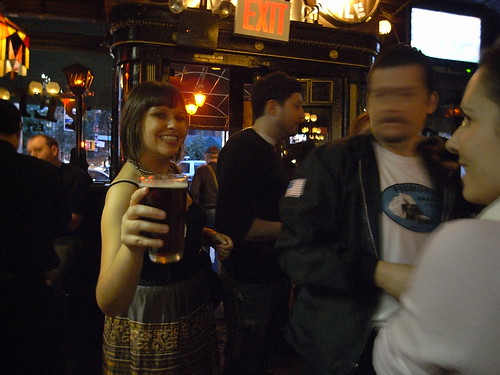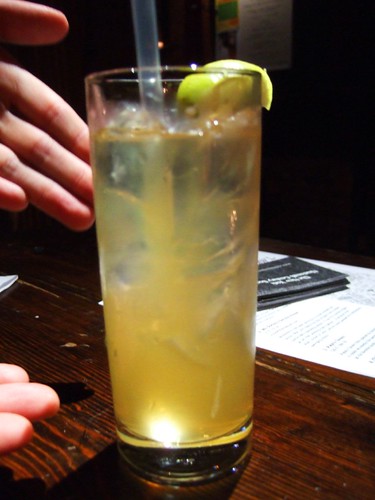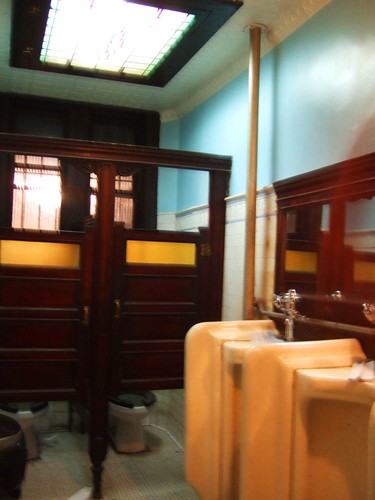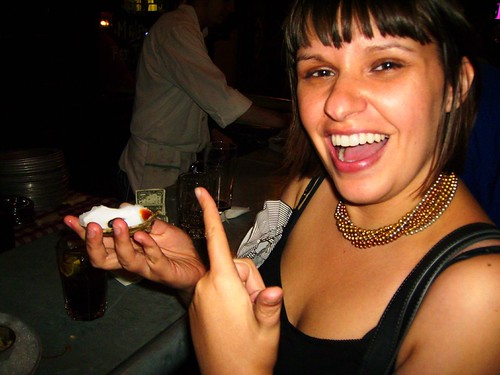The New York Times ran this infatuating article on different bacon brews across the country.
Category Archives: beer
The 19th Century Pub Crawl a Great Success!
 Downing the Original 1864 House Ale at Pete’s Tavern. Photo by Ilana Kohn.
Downing the Original 1864 House Ale at Pete’s Tavern. Photo by Ilana Kohn.
I am pleased to report that the 19th Century Pub Crawl was a rousing success! Over forty people turned out and we covered five bars, from E 4th st. to E 55th. A small group even made it all the way to PJ Clark’s.
We were a motley crew, all ages and backgrounds, brought together by our mutual love of history. Additionally, there were some impressively costumed ladies sporting full 19th century garb, corsets and all. A couple fine gals even came straight from their jobs as historic interpreters at Old Bethpage Village. I don’t think a more convivial group could be found anywhere on the streets of New York that night.
We began our crawl at Swift, a modern bar whose decor and cocktail menu are inspired by the writings of Jonathon Swift. I tried one the bar’s original cocktails, the Captain Gulliver, a combination of Jameson, Ginger beer, and lemon. I had wanted to try the ginger beer, which is so 19th century, but it was non-alcoholic. This cocktail was the perfect solution.
of Jameson, Ginger beer, and lemon. I had wanted to try the ginger beer, which is so 19th century, but it was non-alcoholic. This cocktail was the perfect solution.
Left: The Captain Gulliver
Next I led the group to McSorely’s, who have been serving their light and dark house brew since their establishment in 1854. The light beer allegedly tastes like cream soda. I ended up not going in: McSorely’s is a cornerstone of drinking at NYU, so the bar was already packed by the time we arrived at 6:30. Half of the crawl decided to stop in, and met up with us later, while the rest of us continued to our third stop, Pete’s Tavern.
Pete’s is also known for the house brew they have served up since 1864. It looks like a dark beer, but tastes like Miller Light. This beer marked a definite turn in my sobriety and in the sobriety of my cohorts.
The interior was beautiful, the bartender gracious, and the staff incredibly tolerant of our drunken antics. I’d stop in Pete’s any day.

Next, we headed down the street to nearby Old Town Bar. At this point, we were famished, so several of us gorged ourselves on the bar’s delicious burgers and fries. I also sent my friend Marc to gather reconnaissance in the men’s bathroom. The marble urinals, “made by Hinsdale in 1910,” are impressive enough that Old Town mentions them on their website. The tavern’s dumbwaiter is also the oldest one operating in the city, and pretty cool to see in action.
Right: The infamous urinals. Overall, a beautiful bathroom.
Lastly, we grabbed a cab and headed uptown to our final destination: PJ Clark’s. After gorging ourselves (again) on a plate of onions rings so crispy they taste like green bean casserole, I noticed that they had an oyster bar. I was thrilled. “How Victorian!” I squealed. In every period source and novel I have read, haughty men are slurping down bivalves by the plateful.
I’d never had an oyster before, so I ordered one for myself and one for Marc. To be honest, I was expecting something squishy and revolting, and misery loves company. We loaded up with condiments and sucked them down, and were surprisingly not disgusted. They just tasted like salt. Or maybe I was wasted.
My evening ended by climbing into a cab bound for Queens. Upon arriving home, I left a trail of my clothing and personal items from my front door to my bed, where I promptly passed out. The next morning, I felt as though I had been struck by a moving carriage. If this were the 19th century, I’d be one step away from McGurk’s.
To see more photos from the event, swing by our group on Flickr here. And if you’re a Flickr member, and attended the event, feel free to add your own photos to our group pool.
We’re already planning another crawl this spring, following the bars on Manhattan’s west side that formerly served the harbor’s sailors, seamen, and other rugged sorts. And is New York the only city where a woman can wear an 1860’s dress with punk-red hair and not be looked at twice? We’re going to find out, because we’re bringing the Crawl to Boston. Stay tuned for more news.
Save the Date: The 19th Century Pub Crawl
Are you in New York? Do you like history? Do you like alcohol? Then put this on your calendar:
.jpg)
Come join us for a full night of nineteenth-century debauchery at several of New York City’s oldest bars and most notorious dens of vice.
We will meet promptly at 5 PM in front of the Merchant’s House Museum (29 East 4th Street). Our evening will commence at Swift, then proceed to Death & Company; McSorely’s Old Ale House; Pete’s Tavern; Old Town Bar; Keen’s Steakhouse; and, should we still possess the fortitude and sobriety, P.J. Clarke’s.
The Pint Sized Farm
The history museum that gave birth to my 19th century obsessions is now home to a garden sponsored by the Great Lakes Brewing Company. Great Lakes is growing herbs and vegetables in its Cleveland restaurant, and for brewing beer.
Dogfish Brewery Releases Three New Old Beers
From Scientific American:
The Revolutionary War Party!
Tasting Ancient Beer
Right: Spruce beer awaits, while a mint julep lurks in the background.
 I spent my memorial day weekend with friends in the rolling green hills of Akron, Ohio. Since several of them have been working on home brewing projects, I had the unique pleasure of sampling some home-brewed beers.
I spent my memorial day weekend with friends in the rolling green hills of Akron, Ohio. Since several of them have been working on home brewing projects, I had the unique pleasure of sampling some home-brewed beers.
boil for 20 mins. Sanitize remaining tools.
Sugars will be 1 brown sugar cone (6oz) and approzimately 2.5oz pure
maple syrup.
Hops will be Northern Brewer pellets, .15oz for bittering, .1oz for flavoring.
#1728 scottish ale yeast, 1/2 pkt.
3/8 tsp spruce essence
Once water temp hit 170 deg, added ‘buckwheat packet’ to steep for 15
mins (don’t know if this will have any effect.) It was a tea bag
replaced with buckwheat flour to try to impart a grain flavor.
Bring back to boil, add bittering hops for 30 mins.
Add flavor hops for 10 mins to boil.
Add spruce essence for 5 mins to boil.
cool to 80 deg, slosh back and forth in fermenter.
Add yeast, cap.
-The hot break was seemingly endless, which was quite annoying. The
small batch makes for a lot of water loss, so I had to keep a lid on
it. But with a lid on it the pot foams up a lot, and then you take
the lid off and all the hops are stuck to the side of the pot. Then I
stir them back in and get another hot break, ad nauseum.
There was still a tremendous amount of fluid loss, probably 3/4 of the
pot boiled away. I used water that went through a pur filter and then
a britta pitcher to bring the volume full.
I used the scottish ale yeast because of its very forgiving
temperature range (55-75f.) Estimated beginning SG is around 1.05, I
expect a 70%
 Mike brought some Midas’ Touch Beer, a commercially brewed beer made from a 2,700 year old recipe:
Mike brought some Midas’ Touch Beer, a commercially brewed beer made from a 2,700 year old recipe:
History Dish Mondays: Ginger Beer

***
Modern recipe adapted from Alton Brown.
1 tablespoon powdered ginger; or 1 1/2 ounces finely grated fresh ginger
1 tsp cream of tartar
1 cup sugar
7 1/2 cups filtered water
1/4 teaspoon active dry yeast
2 tablespoons freshly squeezed lemon juice
If you use fresh ginger, remove from the heat, cover and allow to steep for 1 hour. Pour the syrup through a fine mesh strainer set over a bowl, pressing down to get all of the juice out of the mixture.
If you use ground ginger, remove from heat and add remaining water and lemon juice; set in the refrigerator, uncovered, until at least room temperature, 68 to 72 degrees F.
Using a funnel, pour into a clean 2-liter plastic bottle and add the yeast. The bottle will not be filled to the top–this is necessary to leave room for the yeast to expel gas, carbonating the drink.
Place the cap on the bottle, gently shake to combine and leave the bottle at room temperature for 48 hours. Open and check for desired amount of carbonation. It is important that once you achieve your desired amount of carbonation that you refrigerate the ginger ale. Store in the refrigerator for up to 2 weeks, opening the bottle at least once a day to let out excess carbonation.
You can also try this recipe with molasses for an “Excellent Jumble Beer.”
I found the longer it sat, the better it tasted. A week later, it’s sweet and smooth, and still carbonated. For you home brewing guys out there, I’d love to find out what the alcoholic content is. And if you live in NYC, I still have some left if you’d like to taste it.
Rating: A
This recipe is simple, and an easy introduction to the world of home brewing.

Try This At Home: Spruce Beer

From American Cookery by Amelia Simmons, 1798.
Two friends of mine are attempting to make Spruce Beer, a very old recipe for homemade beer. In America’s early days, Beer was an indispensable household drink, being an important source of fresh water, calories, and in the case of spruce beer, vital nutrients received from the boiling of spruce branches.
Simmon’s recipe uses essence of spruce, which can be purchased in most brewing stores. Or, you can make your own by boiling spruce branches in with the hops, which is a great source of vitamin C. I’ve tried to make this recipe once before and it tasted like ass, but I made a few mistakes that my friends are correcting in their recipe.
Their photo slide show tells the story; they’re bottling their brew this Saturday, and tasting it in another couple weeks. I’ll give you the full report when I have it.
***
Spruce Beer
Ingredients
3 gallons distilled water
48 fl oz blackstrap molasses
2.5oz Fuggles hop pellets
1 tbs spruce essence
1 tsp yeast nutrient
1 packet Nottingham yeast
Supplies
Stock pot with lid
Big Spoon
Thermometer
a few small bowls, such as Pyrex measuring bowls
Fermenter (lidded food-grade pail & bubbler)
Ice
Spray bottle with distilled water
small quantity of vodka
Sanitize everything within a 35 block radius. Put 2 gallons of water into stock pot. Add all molasses to the pot and stir until dissolved. Turn heat on and bring to a boil, stirring frequently. some time while the pot is heating place the third gallon of water and the spruce essence In the fermentor, shaking it vigorously for a few minutes (this adds oxygen into the water.) Once the water has reached a boil, add 2oz of hops pellets. There will be a hot break once the hops are added (the pot will foam) so spray the hot break with the spray bottle to keep it from foaming over. Dissolve the yeast nutrient in a small quantity of water. 5 minutes after the hops pellets were added, add the yeast nutrient. Continue to boil for 10 minutes.
Remove the pot from the stove and place in an ice water bath in the sink. Keep the lid on the pot at this point to keep contaminants out. Use the thermometer to monitor the temperature – once the temperature drops down to around 100 degrees, activate the yeast. Follow the directions on the packet, which will tell you to put the packet and a quantity of warm water in a small bowl and wait 15 minutes.
Pour the liquid contents of the pot into the fermenter, making sure not to dump the sludge from the bottom of the pot in too. Give the pot a quick rinse to get rid of the sludge. Pour (most of) the liquid back and fourth between the pot and fermenter 4-5 times to add more oxygen to the environment. The liquid should end up in the fermenter.
Pour in the activated yeast bowl into the fermenter. Put the lid on the fermenter. Fill the 2 chambers of the bubbler with vodka and insert it into the fermenter lid.
Place the container in a cool place, and wait a week. After 2-3 days if the bubbler is not happily bubbling away, you have likely done a disservice to your yeast and it is dead. You can grab another packet of yeast and get a good culture growing and then add it into the fermenter.
If it does bubble, you should spend this week reflecting on life and catching up on your favorite television episodes.
(thanks to Zaite and Mark S.)





